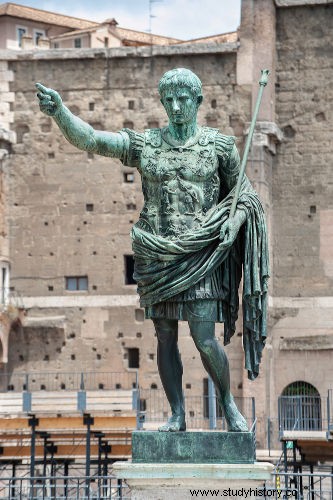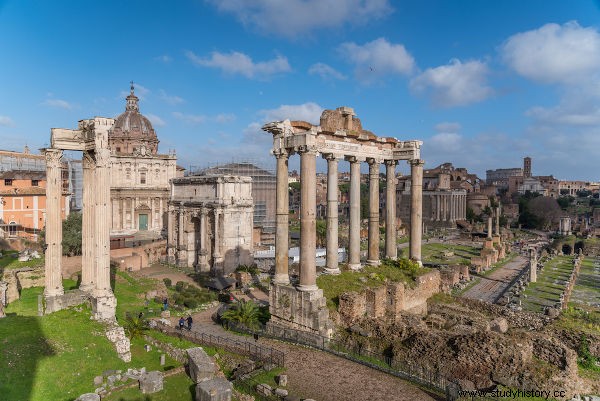Roman Empire is the designation of the last period of the history of the Roman Civilization, although this term is used frequently and generically to refer to the whole historical experience of Rome. This last phase of Roman history is understood as an empire that began in 27 BC, with the coronation of Octavius as emperor, and lasted until 476 AD, when Romulus Augustus was dethroned.
This period had a different political organization in relation to the period of the republic, since the basic characteristic in the empire was the centralization of power in the figure of the emperor. The height of Roman power occurred at this time, but the crisis in the Roman economy and the Germanic invasions brought the empire to an end.
Read more :Roman art and architecture
End of Republic
The emergence of the empire is a consequence of the decline of the republican model, with the Roman Republic experiencing a serious crisis in its last phase, especially in the 2nd and 1st centuries BC. The republican crisis was marked by rebellions popular , rebellions from slaves , dictatorships , wars civilians and a lot of instability in politics .
The new political demands that emerged at this stage, as a result of the growth of the Roman population and the territorial growth of the empire, made the centralization of power emerge as a political alternative. This was when the regions conquered by the Romans began to be annexed, becoming Roman provinces.
The new political needs and new problems were seen as too complex for the Senate's authority. Thus, the figure of a maximum authority as responsible for managing this scenario gained strength. Another important issue is that a new political actor began to consolidate at the end of the republic:the military .
At the end of the republic, Roman generals became popular figures because they led Roman troops . One of the most famous cases was that of Julius Caesar, known for the conquest of Gaul, a region inhabited by the Gauls, people of Celtic origin. The popularization of the military was also influenced by their professionalization , which took place in the middle of the 2nd century BC
This whole scenario created an arena of tensions and power struggles, and to resolve this situation, the creation of triumvirates was proposed. . This form of government was basically a management of Rome by three people chosen for the office. The first triumvirate was formed by Julius Caesar, Crassus and Pompey and led to a civil war.
The three rulers vied with each other for power, and the winner was Julius Caesar , who rose as dictator lifetime over Rome in 46 BC. In this role, his powers were unlimited, but they were short-lived, because several members of the Senate conspired against the dictator and murdered him in 44 BC
This formed a second triumvirate, and the chosen rulers were Octavius, Mark Antony and Lepidus . A new civil war erupted, caused by the same reason that had happened in the first triumvirate:dispute for power. Lepidus abandoned his pretensions, and the dispute was between Octavius and Mark Antony. Octavius emerged victorious, and Mark Antony committed suicide in 30 BC
Victory in the war made Octavius an extremely powerful figure in Rome. He owned an expressive military force and still had popular support, and the result was inevitable:the Senate was forced to cede its power to Otávio, causing him to become emperor Roman.
Octavius has been turned into Princeps Senatus , the first of the senators, a position that gave him great political power and authority over the Senate. He was also named commander-in-chief of the Roman armies, a position known as Imperator, and received the title of Augustus , which made him a sacred figure (in the same religious sense) in Rome.
Early Roman Empire

Octavius' ascension to the throne and his transformation into emperor of Rome took place in 27 BC. and marked the beginning of the last phase of Roman history:the empire. As emperor, he concentrated political power in himself, and the Senate was an institution with secondary power. Octavius remained in that position until 14 A.D.
His reign was marked by his skill policy, and he managed to promote one of the most prosperous governments in Roman history. Rather than defying the Senate, he preferred to govern with that institution on his side, and for that he did not attack senators' privileges , ensuring a climate of stability, although some problems have appeared.
Despite his unrestricted powers, he ensured that Roman politics operated along similar lines to those existing in the republic. In addition to political stability, his government was prosperous and he knew how to guarantee the satisfaction of the Roman provinces , which allowed the maintenance of the territory of the Roman Empire.
With relative political stability and internal peace, Octavius was able to revitalize Rome and ensure the economic development of the empire . Among the revitalization works promoted during his management is the improvement of the empire's infrastructure with the development of roads and the construction of aqueducts.
These works took place not only in Rome, but throughout the empire, especially in the most rebellious provinces. This was part of a strategy by Pax Romana :works that guaranteed the economic development of the provinces in exchange for fidelity and peace. The positioning of troops in strategic locations , especially in the limits of the empire, and the imposition of Roman culture were other mechanisms used to conquer this loyalty.
It is then considered that the reign of Octavius was responsible for initiating the Pax Romana. Despite this, it was not entirely a period of peace, because the Romans continued to fight their wars of conquest and internal problems still existed, but, in relation to the end of the republic, it was a much more stable period. After Octavius' death, the Roman throne was succeeded by Tiberius , your adopted son.
Login also :Roman political organization
Administration and economics
The power of the emperors, although absolute, was fragile, as different interests could turn against them, and therefore conspiracies often took place and emperors were assassinated. Despite then holding the power political , military and religious , the emperor should be concerned with the army, a group that frequently turned against the Roman maximum authority, and with the provinces, being essential to guarantee their satisfaction.

The satisfaction of provinces , their stability and their fidelity were fundamental because they produced the bulk of what was consumed in Rome , especially food. Much of the food consumed in Rome came from Hispania, the Iberian Peninsula, and North Africa. The guarantee of the productivity of these places, in turn, involved obtaining slave workers, fundamental figures in the Roman economy.
Roman dynasties
The imperial phase, as we have seen, extended from 27 BC. to 476 A.D. Historians on the subject have created a division of this phase into four dynasties that existed from 27 BC. to 235 A.D. From 235 A.D. onwards, begins the crisis of the 3rd century AD . and, therefore, the crisis of the Roman Empire begins.
The four Roman dynasties were:
-
Julio-Claudian Dynasty (27 BC-68 AD)
-
Flavian Dynasty (AD 69-96)
-
Nerva-Antonine Dynasty (AD 96-192)
-
Severe Dynasty (AD 193-235)
Login also :Timeline – Ancient Age
Crisis of the Roman Empire
The 3rd century AD it is, therefore, the beginning of the Roman crisis, which lasted for more than 200 years, making the end of Roman history one of agony. The economy it was the first area of the empire that showed its weakening, and this was directly related to the system slavery .
As mentioned, slave labor was essential for Roman productivity to remain at acceptable levels. This dependence caused the economy to stagnate as the number of slaves obtained for work began to decline. This cause was directly related to the decrease in wars of conquest , sources for obtaining slaves for Rome.
The economic crisis affected the Roman Empire in different areas, but mainly in an area vital for its security:the maintenance of troops . Sustaining an army was very expensive, and with the weakened economy, maintaining the number of soldiers was no longer possible. Reducing troops left important areas of the empire unprotected , especially the borders.
Also, it was necessary to increase taxes , which undermined the social stability of the empire. Many reforms were carried out, but, with their failure, it was decided, during the reign of Theodosius, to divide the Roman Empire in the year 395. Administering an empire the size of Rome in a centralized manner proved unfeasible.

The loss of Roman political power was already noticeable at that time because, since 330, the capital of the empire was no longer Rome but Constantinople. With the division came Western Roman Empire and Eastern Roman Empire , each with its own capital. The eastern part, prosperous and stable, survived, but the western part, impoverished and weakened, succumbed.
The coup de grace on the Roman Empire was given by the peoples Germans , who lived beyond the Roman borders and who, from the 3rd century AD, began to migrate, seeking to invade Roman territory:these were the Germanic invasions. Different peoples such as Saxons , Visigoths and vandals , waged war against Rome.
The end of the Roman Empire took place in 476, when the heruli invaded Rome and Odoacer , leader of this Germanic people, dismissed Romulus August , the last emperor. The eastern part continued to exist, but as a Byzantine Empire, and survived until 1453. If you want to delve into the last moment of Greek Civilization, read:Crisis in the Roman Empire.
